Neoville Board Game Review
Frank Lloyd Wright has been my favorite architect as long as I can remember. His modern organic architecture has been an inspiration to many of today’s prominent architects. Falling Water, a house designed by Frank in 1935, exemplifies his philosophy of organic architecture with the harmonious union of art and nature.
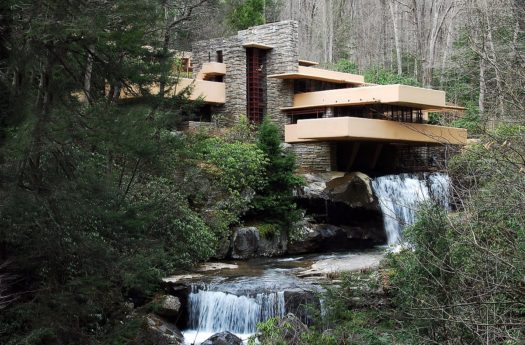

Blue Orange Games new release, Neoville, picks right up on this theme of bio-architecture as players take on the role of an architect creating a new kind of city where the buildings conform to their surrounding and nature is the star.
Create giant stone edifices, fluid water buildings, tall tree towers or mighty clay high-rises bringing harmony to your city and prestige to you.
How to play Neoville
In Neoville, players build out their own 4×4 city by strategically positioning terrain tiles to build skyscrapers and utilities. Skyscrapers are worth harmony points at the end of the game based on their value and district size. And utilities are worth harmony points when their position fits their own requirements. However, skyscrapers ane utilities that don’t meet their requirements count as negative points.
Who will design the most harmonious city with nature?
Setup
Players first sort the Skyscrapers by type – with some being removed based on the number of players. Players then choose 2 types of the Utility buildings to play with. These are placed next to the Skyscrapers.
Players now separate the starting tiles from the regular tiles and shuffle the regular tiles creating 2 face-down draw piles. 4 tiles are then placed face-up in a row next to the draw piles. Next, players take the starting tiles based on the order of play–with the 1st player taking tile #1 and so on.
Each player is then dealt 2 tiles from the face-down draw pile, getting a hand of 3 tiles and they’re ready to begin.
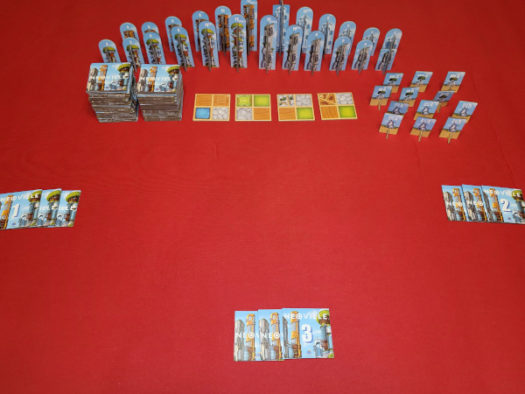
Game Play
Neoville is played over 16 rounds were each player takes the following 3 actions:
ACTION 1: Place a Tile from their hand into the city tableau. Tiles played into a city must line up with a previously played tile (ie. no overlapping edges) and the city can never be more than 4 tiles wide by 4 tiles tall. When placing tiles, players try to create “districts” which are sets of terrain squares connected through multiple tiles. Districts can be grass, water, dirt or stone. Players create these districts in order to place Skyscrapers and Utilities to score points.
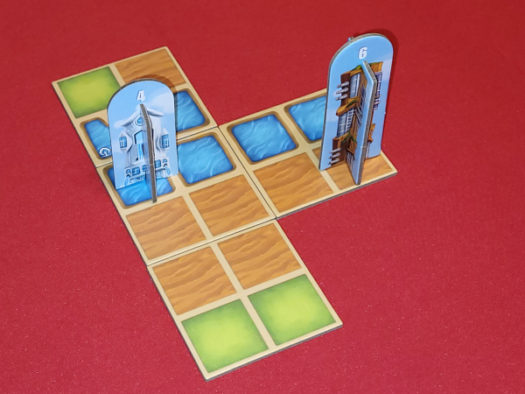
ACTION 2: Optional. Add a Skyscraper or Utility to their city. After placing their tile into their city, a player may add a Skyscraper or Utility. A Skyscraper must be in the corresponding terrain district. For example, a water building in a water district. It can not be added to a district that already has another skyscraper and it can’t be placed on a square with a park or recreation symbol on it.

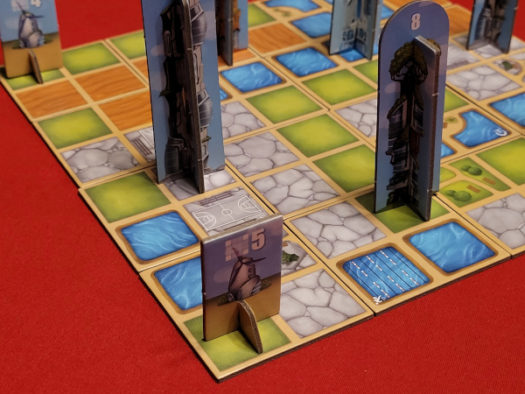
ACTION 3: Draw a new tile. The player now takes a new tile from the 4 available face up tiles or the top of a draw stack. If a face up tile was chosen, replace it with a tile from the draw stack.
Play now passes to the player on the left and continues until each player has completed their 4×4 city.
Final Scoring
Players earn Harmony points based on the numbers listed on their Skyscrapers and Utility buildings if the correct conditions were met over the course of the game.
For example, if a player has a water Skyscraper in a water district with a value of 8, the water district must be at minimum 8 water terrain squares orthogonally connected. If the condition has not been met, then that player looses that many points.
Utility buildings work similarly–needing to be in the proper position in order to score (or lose points if they are not). Players also earn 5 points for having the most park symbols in their city and 5 points for having the most recreational symbols in their city.
Example scoring:


The player with the most Harmony points at the end of scoring, wins!
The Breakdown
The designer of Neoville, Phil Walker-Harding, recently designed another city building game for Blue Orange Games titled Cloud City. They both have the same tile laying and race for scoring components mechanics, but the similarities between the two ends there. In his latest release, Phil focuses more on the creation of the city’s foundation than the buildings themselves. This creates a fun little puzzle that players will have to work out in order to place buildings and utilities to score points.
Theme and Mechanics:
3 out of 4 of my latest reviews have been city building games and there’s a reason for it–I love the theme!
There’s something great about seeing a city grow before your eyes and I have always loved architecture and city skylines.
As mentioned above, Neoville has a unique district building mechanic which challenges players to be able to place the different skyscrapers and utilities into their cities. This ties in nicely with the theme of creating the city around nature as you must build up the natural areas to support the buildings.
Also mentioned previously is the race mechanic where players race to get buildings and utilities that fit their city best. There are a limited number of both available so players find themselves risking losing points if they grab a building they can’t finish the district for.
Flow and accessibility:
The age recommendation on the box says 10 years and up. However I think it can be easily played by a much younger audience. I would say 8 years old would be a better suggestion.
As I mention with most Blue Orange Games, Neoville is easy to set up, learn, teach, and play–making it very accessible to a wide range of ages and player levels. With only 3 steps to a player’s turn there’s not much down time. That being said, there’s still plenty of choices and player interaction throughout the course of the game to keep it interesting.
Production Value:

How does Neoville score on our “Let’s Play Again” game meter?
Neoville is another solid title from Blue Orange Games that’s great for the whole family. The ease and length of play scores high on our “let’s play again” game meter.
However, we have a lot of other titles on our shelf vying for our attention including several city builders. For example, the afore mentioned Cloud City which for me and my tastes I see us playing more often as it has a better visual presence on the table and a more enjoyable puzzle aspect to it. If I’m looking for a meatier city builder, I’ll grab Suburbia, Magnate or Cape May.
All that being said, players who like lighter games, city builders, and tile laying games will like Neoville.
About the Author
Dane is an Advertising and Layout Manager for a national magazine by day and a husband, father of four, and board gamer by night. He has a passion for board games and believes board games help bring families closer together while providing kids a unique way to learn many diverse skills. And he thinks they’re downright fun!!!
The Board Game Family would like to thank Blue Orange Games for a review copy of Neoville.



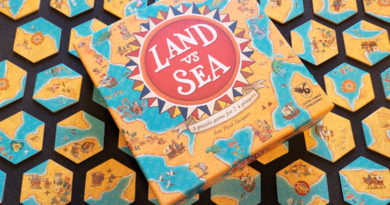


It has a fairly simple set up and pull down is a breeze with a basic insert that holds & separates things. I like the component quality too with simple but sturdy cardboard structures and tiles with The SIMS styles artwork.
We love easy set up and take down. If a game takes too long to set up I typically have to send the family away and have them come back when I am done. Keeps the fights down. 🙂
Dane,
Thank you for this review–well-written and informative as always.
Is there any sense in which this game is an engine-builder? Did it feel like you were gaining momentum during the course of the game?
Hi Chris,
Nope, not at all.
If you are looking for something like that, Gizmos, Imperial Settlers, Fantastic Factories are good choices.
Dane
Thanks! I also love the city placement in Tapestry, though that’s a heavier weight have, of course.
Hey Chris,
I haven’t had the chance to play that one yet. Hopefully one of these days.